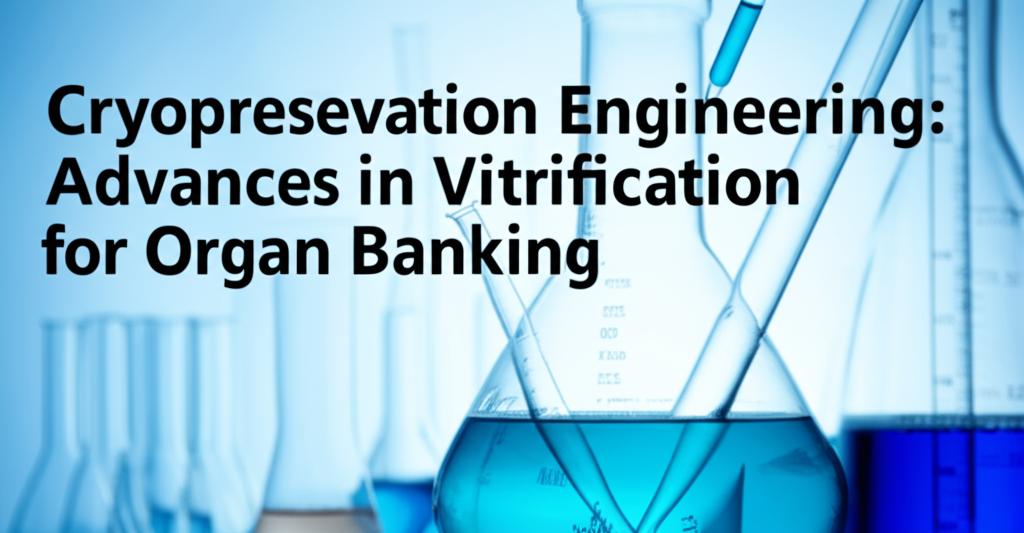The prospect of long-term organ banking through vitrification, a process of ice-free cryopreservation, is a significant step towards revolutionizing transplant medicine. Vitrification involves cooling biological materials to a glass-like state at ultra-low temperatures, typically around -150°C, thereby halting biological processes without the damaging effects of ice crystal formation. This technology could transform organ transplantation from an urgent, time-sensitive procedure into a planned one, improving patient outcomes and organ allocation equity.
Recent Breakthroughs and Current State:Significant progress has been made in vitrifying and rewarming organs. Notably, researchers have successfully vitrified and rewarmed rodent kidneys, which were then transplanted and sustained life in recipients for up to 100 days. This marks a substantial advancement from earlier attempts and provides proof-of-principle for the concept of organ banking. While embryonic kidneys have been successfully vitrified and transplanted in mice, scaling up the technology to human-sized organs remains a key focus.
Recent experimental successes include the vitrification of a porcine liver (approximately 1 liter) and the demonstration of vitrification and nanowarming in up to 2-liter volumes of cryoprotective agent (CPA) solutions, a scale relevant for human kidneys and hearts. Human livers may require vitrification of 3 liters or more.
Key Challenges in Organ Vitrification:Despite these advances, several challenges must be overcome to make large-scale organ vitrification a clinical reality:
- Ice Crystal Formation (Devitrification): Preventing ice crystal formation during both cooling and rewarming is critical. Ice crystals can cause severe damage to cells and tissues. This is particularly challenging in larger organs due to heat and mass transfer limitations.
- Cryoprotectant Toxicity: High concentrations of CPAs are necessary to achieve vitrification and prevent ice formation. However, these CPAs can be toxic to cells and organs. Research focuses on developing less toxic CPA mixtures and optimizing perfusion protocols to load and unload CPAs effectively, minimizing exposure and osmotic stress. Mathematical modeling is being used to aid in the development of low-toxicity vitrification solutions.
- Uniform and Rapid Rewarming: Rewarming vitrified organs quickly and uniformly is crucial to prevent devitrification and cracking due to thermal stress. Convective warming (e.g., immersion in a warm bath) is sufficient for small samples but fails for larger volumes.
- Heat and Mass Transfer: Ensuring uniform cooling and CPA distribution throughout large, complex organs is difficult due to their volume and variations in tissue density and vascularity. This can lead to non-uniform vitrification and thermal stress.
- Scaling to Human Organs: Techniques successful in small animal models need to be scalable to the size and complexity of human organs. This involves not only the vitrification and rewarming processes but also assessing organ viability post-rewarming.
A groundbreaking advancement in addressing the rewarming challenge is "nanowarming." This technique involves perfusing organs with iron oxide nanoparticles (IONPs) before vitrification. These nanoparticles are typically silica-coated for stability and biocompatibility. During rewarming, an alternating magnetic field is applied, causing the IONPs within the organ's vasculature to generate heat rapidly and uniformly from within. This method overcomes the limitations of convective warming for large volumes.
- Mechanism: The magnetic field induces an oscillatory response in the nanoparticles, generating heat through magnetic hysteresis or Joule heating (eddy currents).
- Advantages: Nanowarming allows for much faster and more uniform rewarming rates (e.g., ~88°C/min in 2L volumes) compared to conventional methods. Radiofrequency waves used in this process can penetrate tissues without significant attenuation, making the approach scalable to human organs.
- Recent Developments: Researchers are refining nanoparticle design to enhance heating efficiency while minimizing potential toxicity. Magnetic nanowires are also being explored as potential heating agents. A two-step nanowarming process using magnetic nanorods has shown promise in safely rewarming frozen pig carotid arteries with high cell viability.
- Hypothermic Machine Perfusion (HMP) and Normothermic Machine Perfusion (NMP): While not vitrification, these techniques extend organ viability by perfusing them with oxygenated solutions at cold or body temperatures, respectively. NMP, in particular, might be used in conjunction with vitrification to assess organ viability after rewarming.
- Supercooling and Isochoric Preservation: These are other subzero preservation methods being explored. Supercooling aims to keep organs below freezing without ice formation, while isochoric (constant volume) preservation may reduce the required CPA concentrations.
- Optimizing Cooling and Warming Rates: The precise rates of cooling and warming are critical and vary depending on the organ and CPA used. Controlled-rate freezers are employed for the cooling process.
- Addressing Chilling Injury: Even in the absence of ice, cooling to subzero temperatures can cause "chilling injury." Research continues to find CPA formulations and protocols that mitigate this type of damage.
The future of organ banking through vitrification hinges on continued interdisciplinary research. Key priorities include:
- Developing Novel Cryoprotectants: The search for more effective and less toxic CPAs is ongoing.
- Refining Rewarming Technologies: Further advancements in nanowarming and other volumetric heating methods are crucial for consistent success with human-sized organs.
- Understanding Cryoinjury Mechanisms: Deeper insights into the cellular and molecular damage occurring during cryopreservation will inform the development of better protective strategies.
- Improving Viability Assessment: Reliable methods to assess organ function and viability after vitrification and rewarming are essential before clinical application.
- Scaling Up Protocols: Successfully transitioning from small animal models to human organs requires meticulous optimization of all steps, from CPA perfusion to nanowarming.
The ability to bank organs for extended periods would significantly reduce organ discard rates, facilitate better donor-recipient matching, allow for planned transplant surgeries, and potentially eliminate waiting lists. While challenges remain, the recent advances in vitrification and particularly nanowarming have brought the prospect of routine organ banking closer than ever before, promising a transformative impact on transplantation medicine.

